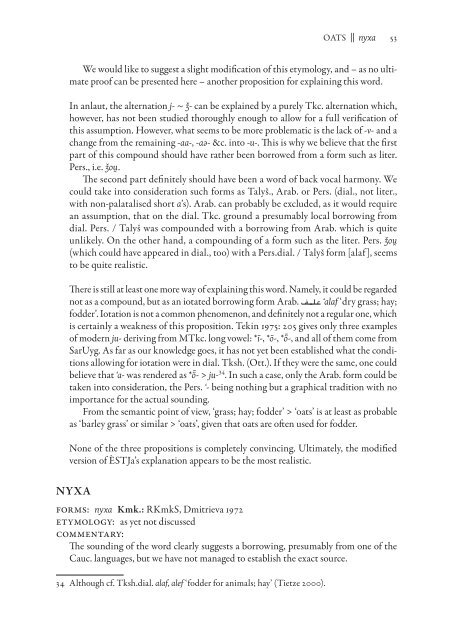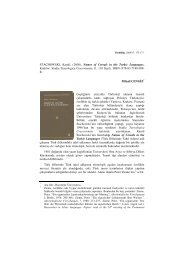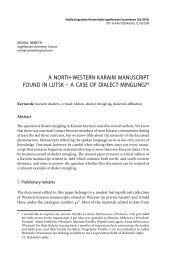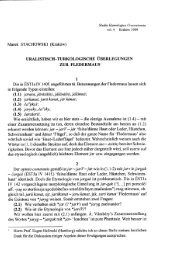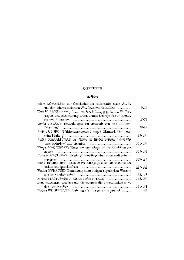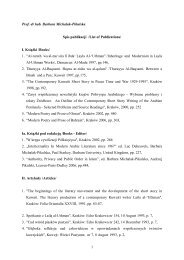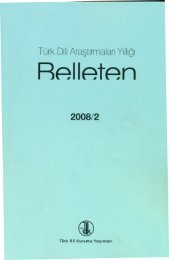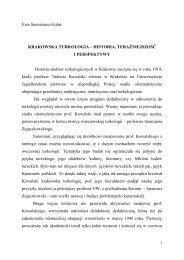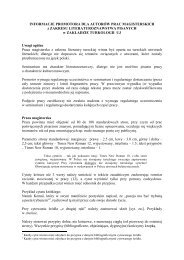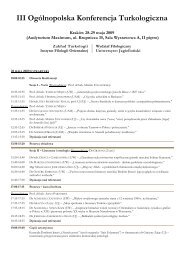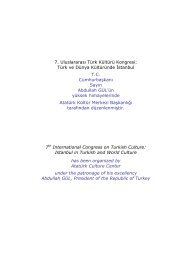Names of Cereals in the Turkic Languages - Wydział Filologiczny UJ
Names of Cereals in the Turkic Languages - Wydział Filologiczny UJ
Names of Cereals in the Turkic Languages - Wydział Filologiczny UJ
- No tags were found...
You also want an ePaper? Increase the reach of your titles
YUMPU automatically turns print PDFs into web optimized ePapers that Google loves.
Oats || nyxa 53We would like to suggest a slight modification <strong>of</strong> this etymology, and – as no ultimatepro<strong>of</strong> can be presented here – ano<strong>the</strong>r proposition for expla<strong>in</strong><strong>in</strong>g this word.In anlaut, <strong>the</strong> alternation j- ~ ǯ- can be expla<strong>in</strong>ed by a purely Tkc. alternation which,however, has not been studied thoroughly enough to allow for a full verification <strong>of</strong>this assumption. However, what seems to be more problematic is <strong>the</strong> lack <strong>of</strong> -v- and achange from <strong>the</strong> rema<strong>in</strong><strong>in</strong>g -aa-, -aə- &c. <strong>in</strong>to -u-. This is why we believe that <strong>the</strong> firstpart <strong>of</strong> this compound should have ra<strong>the</strong>r been borrowed from a form such as liter.Pers., i.e. ǯou.The second part def<strong>in</strong>itely should have been a word <strong>of</strong> back vocal harmony. Wecould take <strong>in</strong>to consideration such forms as Talyš., Arab. or Pers. (dial., not liter.,with non-palatalised short a’s). Arab. can probably be excluded, as it would requirean assumption, that on <strong>the</strong> dial. Tkc. ground a presumably local borrow<strong>in</strong>g fromdial. Pers. / Talyš was compounded with a borrow<strong>in</strong>g from Arab. which is quiteunlikely. On <strong>the</strong> o<strong>the</strong>r hand, a compound<strong>in</strong>g <strong>of</strong> a form such as <strong>the</strong> liter. Pers. ǯou(which could have appeared <strong>in</strong> dial., too) with a Pers.dial. / Talyš form [alaf], seemsto be quite realistic.There is still at least one more way <strong>of</strong> expla<strong>in</strong><strong>in</strong>g this word. Namely, it could be regardednot as a compound, but as an iotated borrow<strong>in</strong>g form Arab. علف ‘alaf ‘dry grass; hay;fodder’. Iotation is not a common phenomenon, and def<strong>in</strong>itely not a regular one, whichis certa<strong>in</strong>ly a weakness <strong>of</strong> this proposition. Tek<strong>in</strong> 1975: 205 gives only three examples<strong>of</strong> modern ju- deriv<strong>in</strong>g from MTkc. long vowel: *ī-, *ō-, *ȫ-, and all <strong>of</strong> <strong>the</strong>m come fromSarUyg. As far as our knowledge goes, it has not yet been established what <strong>the</strong> conditionsallow<strong>in</strong>g for iotation were <strong>in</strong> dial. Tksh. (Ott.). If <strong>the</strong>y were <strong>the</strong> same, one couldbelieve that ‘a- was rendered as *ȫ- > ju- 34 . In such a case, only <strong>the</strong> Arab. form could betaken <strong>in</strong>to consideration, <strong>the</strong> Pers. ‘- be<strong>in</strong>g noth<strong>in</strong>g but a graphical tradition with noimportance for <strong>the</strong> actual sound<strong>in</strong>g.From <strong>the</strong> semantic po<strong>in</strong>t <strong>of</strong> view, ‘grass; hay; fodder’ > ‘oats’ is at least as probableas ‘barley grass’ or similar > ‘oats’, given that oats are <strong>of</strong>ten used for fodder.None <strong>of</strong> <strong>the</strong> three propositions is completely conv<strong>in</strong>c<strong>in</strong>g. Ultimately, <strong>the</strong> modifiedversion <strong>of</strong> ÈSTJa’s explanation appears to be <strong>the</strong> most realistic.nyxaforms: nyxa Kmk.: RKmkS, Dmitrieva 1972etymology: as yet not discussedcommentary:The sound<strong>in</strong>g <strong>of</strong> <strong>the</strong> word clearly suggests a borrow<strong>in</strong>g, presumably from one <strong>of</strong> <strong>the</strong>Cauc. languages, but we have not managed to establish <strong>the</strong> exact source.34 Although cf. Tksh.dial. alaf, alef ‘fodder for animals; hay’ (Tietze 2000).


